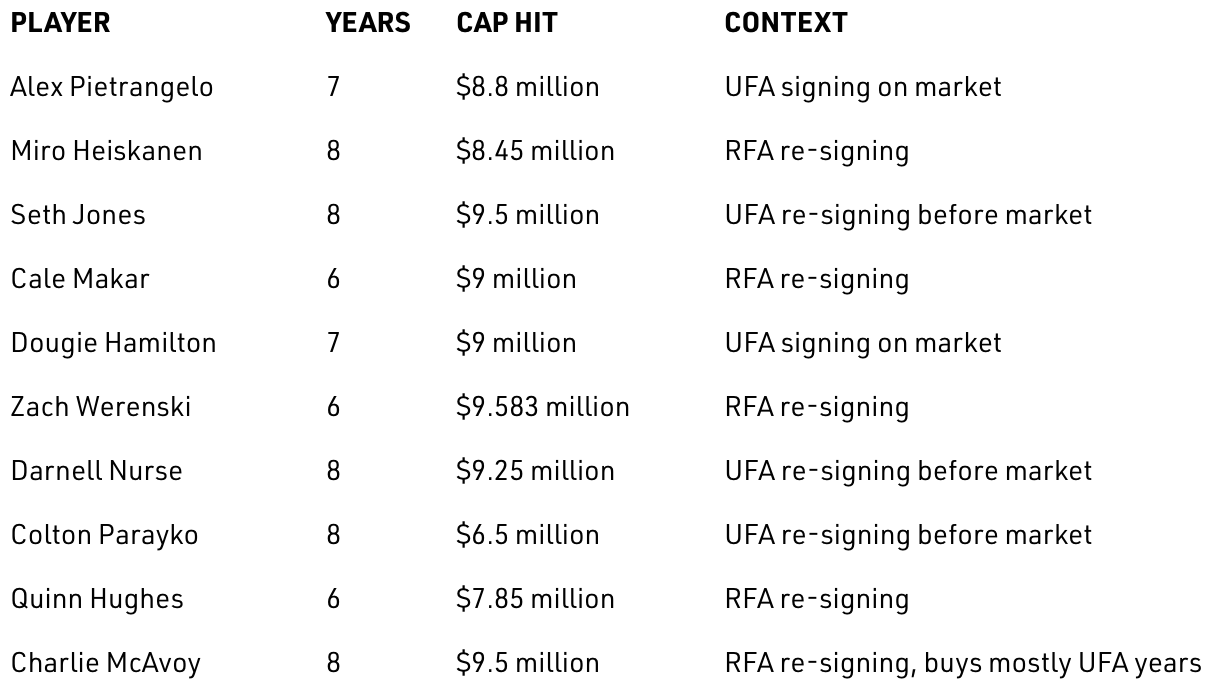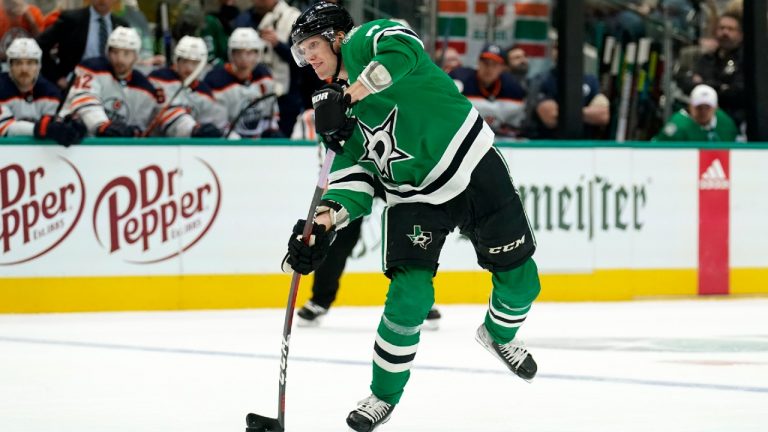The defence market has been an especially fascinating place over the past year. It’s also been a lucrative one for the top players. Good work, if you can get it.
Last weekend brought key developments in the defence market story. We knew Jakob Chychrun’s name was in the rumour mill, and that it could lead to a move soon-ish, before we are within the March 21 trade deadline’s orbit.
John Klingberg‘s name also came to the fore as someone who might be available. The 29-year-old is unsigned beyond this season and scheduled to become a UFA after blue-line mates Miro Heiskanen (8 years, $8.45 million) and Esa Lindell (6 years, $5.8 million) were extended the past two years and Ryan Suter was signed off the market (4 years, $3.65 million) last summer.
Although Klingberg clarified to the media that he hadn’t made a formal request to get traded ASAP, he did admit to some frustration with his contract talks, or lack thereof, with the team.
“Other guys have signed right before the season before. I wanted to do that as well,” Klingberg said. “Lately, it has been going more quietly and quietly. For me, as a player, I don’t feel that I’ve been appreciated in that way when we don’t even negotiate. It’s quiet. For me, as a player, my agent, we talked to Jim (Nill) a couple months back. He agreed that we could start talking with other GMs and see where we were at. Negotiation-wise, the Stars have been very quiet.”
So Klingberg and Chychrun are the biggest blue-line names being discussed in trade circles, with more surely to be added in the coming weeks. But they’re players in entirely different situations and not so easily comparable to one another.
Speaking on what the Coyotes might be looking for in return for Chychrun, Sportsnet’s Jeff Marek has floated the idea of a “Brent Burns-type” deal, harkening back to the 2011 draft day Wild-Sharks trade. In that, the Sharks acquired a 26-year-old Burns for young Charlie Coyle, Devin Setoguchi and the 28th overall pick.
A contender, or even middling team, may not have trouble paying up for Chychrun, a young (23) and under control ($4.6 million AAV through 2024-25) defenceman who scored more goals than any other blueliner in 2019-20 and 2020-21 combined.
Klingberg is different in that he’s on an expiring contract, is 29 and, perhaps, with his absolute peak in the past. Not that Klingberg wouldn’t be a great addition to any team — he’d be a phenomenal pick-up — but paying three good young pieces for a rental player in a cap league is a lot.
So what is Klingberg worth? It may take until the March 21 trade deadline for this situation to play out, but we can get an idea of what he may go for in trade, or sign for on a new contract, in the coming months.
What would you give up for rental John Klingberg?
Defencemen, especially rental defencemen, get traded at the deadline. Lots of these are third-pair or No. 7 adds. These are subtle additions or injury insurance and they go for mid- or late-round picks.
Rentals of Klingberg’s calibre aren’t often moved. Alex Pietrangelo was a possibility in 2020, but the St. Louis Blues ultimately kept him and then he became a UFA. For a somewhat comparable situation to Klingberg, we might have to go back to 2019, when the Carolina Hurricanes traded Justin Faulk to St. Louis just before the start of the season. In return, Carolina received Joel Edmundson and first-round prospect Dominik Bokk. Faulk wasn’t a rental for long, though, signing an extension with the Blues on the same day.
This past off-season, the Buffalo Sabres traded Rasmus Ristolainen to Philadelphia ahead of his final contract year, receiving depth defender Robert Hagg, the 14th overall pick (Isak Rosen) and a 2023 second-rounder. Ristolainen remains unsigned and on track to test free agency if the floundering Flyers can’t come to terms with him.

Rank Ristolainen, Faulk and Klingberg, and Dallas’ blueliner should be even more sought after by a decent margin. He can bring you big minutes and put up big numbers — Klingberg has either hit 50 points or paced to that amount in a full 82 games in almost every season of his career.
So the baseline for Klingberg in a trade would seem to start with Ristolainen and Faulk, two fine defenders who you’d likely put beneath Klingberg on a depth chart. Ideally, the Stars would find a trade partner who could sign Klingberg immediately to an extension, and thus drive the price up further.
The gold standard for the Stars would be if they could get something similar to what Columbus did for Seth Jones, though, we must say, that appears unlikely. Jones is Chicago’s alpha and more of an all-situations player, it was an off-season shake-up and the Blackhawks were motivated to acquire and extend their new No. 1. Jones, who wasn’t going to re-sign in Columbus, immediately signed something of a market-setting contract for his position.

The price for Klingberg probably starts at a first-round pick and a top prospect in the system, then goes up if Klingberg can work out a re-sign as part of the deal. His agent is talking to teams, after all.
But the bigger question related to Klingberg’s trade value is how much any of this interests the still-competing Dallas Stars. They are 12th in the West, five points out of the wild card, but with fewer games played than everyone in front of them. By points percentage, the Stars are ninth.[sidebar]
They may need Klingberg around for another playoff push.
“We’re all one or two players or one or two pieces from being either better or worse than somebody else,” Nill told Sirius XM’s Sunday Brunch. “Goaltending comes into play. It’s never been tighter.”
Futures? Futures!? Dallas is still talking about playoffs.
What is John Klingberg’s value on a contract extension?
At the moment, Klingberg is providing incredible value with a $4.25 million AAV. He’s a steal at that rate, but he’ll be 30 years old when his next deal kicks in and his impact on the defensive side has been in decline for a couple years. The Stars are paying top dollar to Jamie Benn and Tyler Seguin, very good players who have dealt with an assortment of injuries that have dulled their production for three years. With Heiskanen locked in at $8.45 million, you might be able to understand Dallas’ reticence in shelling out more top dollars and term to a player in his 30s.
According to Marek, Klingberg’s camp was seeking something in the range of an eight-year deal and $63 million — which comes out to a $7.875 million AAV. In the wacky world of the NHL defencemen market, that rate actually comes off as somewhat reasonable — especially if a new team will elevate him back to top-pair workload.
When Toronto’s Morgan Rielly signed his eight-year extension with a $7.5 million AAV this season, it was perceived that he left money on the table that he could have got on the open market. Rielly is used more on the penalty kill than Klingberg and is two years younger, but the two produce similar levels of offence; Rielly is superior at 5-on-5 and Klingberg is more of a power-play quarterback.
For a refresher, here’s what some No. 1 defencemen signed for on their new deals, from the opening of October 2020 free agency through Rielly’s contract.

If Klingberg does get a $7.85 million AAV, he’d set up to be the 20th-highest-paid defenceman going into next season. Not bad, considering he’s also 20th in points per game among defencemen over the past three years. Not a steal, but reasonable.
It’s also worth pointing out that of those 20 highest-paid blueliners, eight of them are in their 30s and only one or two might be considered bad deals (it’s hard to argue in favour of $11 million for Drew Doughty or $11.5 million for Erik Karlsson). Klingberg wouldn’t bring “bad” value at this rate, it’s more a question of how he’d age through it.
“I don’t know that Dallas gets into the 60s on an eight-year term,” Marek said on his radio show this week. “Here’s the other thing — I don’t know if they want to go eight. The one thing I still don’t know is what is the issue? Is the issue the money or is the issue the term?”
What’s enticing about Klingberg, beyond his obvious offensive generation, puck-moving ability, the fact he’s a right shot and can log a ton of minutes (phew) is the potential for more in a new destination and in the right situation. Since Rick Bowness took over Dallas’ bench, Klingberg’s even-strength minutes have declined somewhat, sitting fourth on the team this season. He still logs a ton of them (18:35 even-strength per game, 21:42 all situations), just not as much as before.
And there’s also discussion wondering if Dallas’ system is the best fit for Klingberg, since it doesn’t really encourage him to rush the puck — it’s an interesting variable explored in detail here by Jack Han.
“It’s been a few frustrating years individually and as a player it all ends up coming to your next contract,” Klingberg said.
There is a top-pair defencemen to be had here — someone who can score a ton of points, log a pile of minutes, and be able to do it on a top pair. Put him next to a defensive specialist and in a system that frees him to rush, and you might have the right conditions.
These types of players don’t often become available, but it seems Klingberg will be on a new team whether it comes before the deadline or this summer. And the cost of acquisition, at the moment, should be something most contenders can stomach.
[relatedlinks]






COMMENTS
When submitting content, please abide by our submission guidelines, and avoid posting profanity, personal attacks or harassment. Should you violate our submissions guidelines, we reserve the right to remove your comments and block your account. Sportsnet reserves the right to close a story’s comment section at any time.